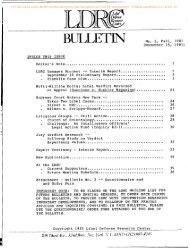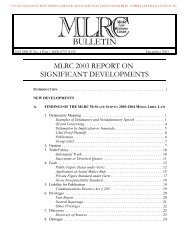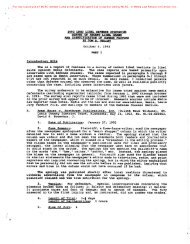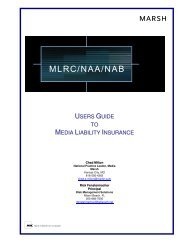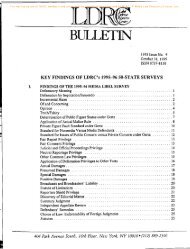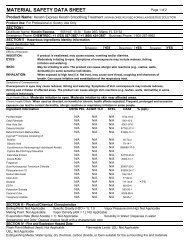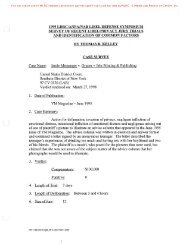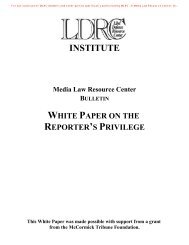MEMORANDUM - Directrouter.com
MEMORANDUM - Directrouter.com
MEMORANDUM - Directrouter.com
You also want an ePaper? Increase the reach of your titles
YUMPU automatically turns print PDFs into web optimized ePapers that Google loves.
For exclusive use of MLRC members and other parties specifically authorized by MLRC. © Media Law Resource Center, Inc.<br />
<strong>MEMORANDUM</strong><br />
TO:<br />
FROM:<br />
MLRC Property & Privacy Panel<br />
Timothy L. Alger, Esq.<br />
Brian W. Collins<br />
DATE: August 1, 2006<br />
RE:<br />
Nominative Fair Use Doctrine<br />
Outline and Hypotheticals<br />
I. INTRODUCTION<br />
The term "nominative fair use" in trademark law was coined to distinguish it from the<br />
statutory or classic defense of "fair use," which arises when a defendant uses a trademark in its<br />
descriptive sense to reference its own product (and the inquiry revolves around whether this<br />
trademark reference might confuse the public as to the relationship between the two). See<br />
15 U.S.C. §1115(b)(4) (2000). Unlike classic fair use and its "likelihood of confusion"<br />
standard, 1 nominative fair use is said to occur when the non-trademark holding party uses a<br />
trademark to reference the trademark holder's product. If the non-holder is not attempting to<br />
confuse the public when it uses the mark, it is a "non-confusing nominative use." Use of the<br />
trademark might be the only reasonable way to identify a particular product or service, or convey<br />
1<br />
The Ninth Circuit has held that in determining whether confusion between related goods is likely, the<br />
following factors are relevant (list is non-exhaustive, as other variables may <strong>com</strong>e into play depending on the<br />
particular facts presented): strength of the mark; proximity of the goods; similarity of the marks; evidence of actual<br />
confusion; marketing channels used; type of goods and the degree of care likely to be exercised by the purchaser;<br />
defendant's intent in selecting the mark; and likelihood of expansion of the product lines. See AMF, Inc. v.<br />
Sleekcraft Boats, 599 F.2d 341, 348-49 (9th Cir. 1979). Other circuits have similar, but not identical, tests.<br />
09325/1929936.1
For exclusive use of MLRC members and other parties specifically authorized by MLRC. © Media Law Resource Center, Inc.<br />
a message that implicates a product or service. 2<br />
As a result, the trademark is not being used in its<br />
primary, descriptive sense, which would call for the classic fair use defense, but rather, such<br />
nominative use of the mark invokes the secondary, trademarked meaning and therefore must be<br />
treated differently.<br />
II.<br />
BACKGROUND<br />
Recognizing the necessity for permitting use of a trademark where no other description<br />
would reasonably suffice, the Ninth Circuit began to articulate boundaries between infringing<br />
and noninfringing use when the defendant non-holder used a trademark to refer to the trademark<br />
holder's product. See Volkswagenwerk Aktiengesellschaft v. Church, 411 F.2d 350, 352 (9th Cir.<br />
1969). The court held that for use of a mark to be acceptable, the manner in which it is used may<br />
not imply an affiliation such as sponsorship or endorsement. See id. (explaining that in using the<br />
word "Volkswagen" in an advertisement for service and repair of Volkswagen vehicles,<br />
defendant may not use the word in such a way that would suggest he is part of the Volkswagen<br />
organization). Additionally, the Ninth Circuit considered the degree to which the trademark is<br />
used, taking into account use of distinctive lettering style or color scheme. See id. Thus, use of a<br />
trademarked name in plain font is more likely to be considered noninfringing than use of the<br />
name as part of its trademarked logo. See id. (noting that the district court properly considered<br />
the appearance of the mark in defendant's advertisement and that it did not appear in the<br />
distinctive Volkswagen lettering, nor encircled in the "VW" emblem). This precedent played a<br />
valuable role when the Ninth Circuit articulated the nominative fair use doctrine in the 1990's.<br />
2<br />
New Kids on the Block v. News America Publishing highlights this concept with the example, "the<br />
professional basketball team from Chicago," which is less efficient and less likely to be understood than the<br />
"Chicago Bulls." 971 F.2d 302, 306 (9th Cir. 1992).<br />
09325/1929936.1 -2-
For exclusive use of MLRC members and other parties specifically authorized by MLRC. © Media Law Resource Center, Inc.<br />
III.<br />
NINTH CIRCUIT'S NOMINATIVE FAIR USE DOCTRINE<br />
A. New Kids on the Block<br />
In 1992, the Ninth Circuit explicitly rejected the traditional trademark infringement<br />
analysis / "likelihood of confusion" test and adopted a new test that would govern nominative<br />
fair use analysis, under which a party might use another's trademark in truthfully referring to a<br />
particular product for purposes of <strong>com</strong>parison, criticism, point of reference and the like. New<br />
Kids on the Block v. News America Publishing, 971 F.2d 302, 308 (9th Cir. 1992); see Cairns v.<br />
Franklin Mint Co., 292 F.3d 1139, 1151 (9th Cir. 2002). At issue in New Kids was whether two<br />
newspapers had violated the Lanham Act when they employed the band's trademark while<br />
conducting polls that asked readers to vote for their favorite member of a famous boy band.<br />
Voters were charged a fee for each vote cast by telephone. The band alleged that the<br />
newspapers' use of the trademarked name in their polls implied that the band was sponsoring the<br />
polls. The court reasoned such nominative use of a trademark – where the only word reasonably<br />
available to describe a particular thing is pressed into service – lies outside the strictures of<br />
trademark law because it does not implicate the source-identification function that is the purpose<br />
of trademark. 292 F.3d at 308.<br />
The court held that a defendant who uses a trademark to describe the plaintiff's product,<br />
rather than its own, is entitled to this nominative fair use defense provided it meets the following<br />
three requirements:<br />
(1) The product or service in question must be one not readily identifiable without use of<br />
the trademark;<br />
(2) Only so much of the mark or marks may be used as is reasonably necessary to<br />
identify the product or service; and<br />
(3) The user must do nothing that would, in conjunction with the mark, suggest<br />
sponsorship or endorsement by the trademark holder.<br />
09325/1929936.1 -3-
For exclusive use of MLRC members and other parties specifically authorized by MLRC. © Media Law Resource Center, Inc.<br />
Id. Thus, the court held that the newspapers did not constitute unfair <strong>com</strong>petition because the<br />
use met all three of the requirements. Id. at 308-09. Further, the court observed that a<br />
nominative use may also be a <strong>com</strong>mercial one because while the band had a service mark right in<br />
its name, “that right does not entitle them to control their fans' use of their money . . . . [T]he<br />
trademark laws do not give the [bandmembers] the right to channel their fans’ enthusiasm (and<br />
dollars) only into items licensed or authorized by them.” Id. at 309.<br />
B. Ninth Circuit Clarifies and Refines the Doctrine<br />
Following New Kids, the Ninth Circuit reiterated that when a nominative fair use defense<br />
is raised, the aforementioned test should be applied in lieu of the likelihood of confusion test<br />
typically used in trademark infringement cases. Playboy Enter., Inc. v. Welles, 279 F.3d 796,<br />
801 (9th Cir. 2002). The court reasoned that since the "likelihood of confusion" test focuses its<br />
analysis on the similarity of the marks, it would be nearly impossible for a defendant to succeed<br />
on a nominative fair use defense that analyzed likelihood of confusion. See id.<br />
However, while the Ninth Circuit justified its creation of the nominative fair use defense,<br />
it struggled with determining when to apply it. Even though it is clear that the defense is<br />
available to a defendant who uses a trademark to refer to the trademark holder's product, to what<br />
it is referring is not always clear – the trademarked product, or ultimately, its own product.<br />
Subsequently, the Ninth Circuit decided that the nominative fair use defense is appropriate where<br />
the defendant uses a trademark to describe the trademark holder's product – even in situations<br />
where the ultimate reference is to the defendant's own product – while classic fair use is left to<br />
cases where the defendant uses a trademark to describe only its own product. Cairns v. Franklin<br />
Mint Co., 292 F.3d 1139, 1151 (9th Cir. 2002).<br />
09325/1929936.1 -4-
For exclusive use of MLRC members and other parties specifically authorized by MLRC. © Media Law Resource Center, Inc.<br />
IV.<br />
NOMINATIVE FAIR USE OUTSIDE THE NINTH CIRCUIT<br />
A. Interpretation by Other Circuits<br />
Largely because so many trademark infringement cases are heard by the Ninth Circuit,<br />
few other courts have spoken on the precise issue of how the nominative fair use defense is<br />
successfully invoked. Moreover, the courts that have referenced the defense by name have done<br />
so only in reference to what district courts had done with the issue or to decline to adopt the<br />
Ninth Circuit's test as a whole. See, e.g., Chambers v. Time Warner, Inc., 282 F.3d 147, 156 (2d<br />
Cir. 2002) (noting that the district court applied the standard for nominative fair use as<br />
articulated by the Ninth Circuit, but finding that the court had erred in its application); see also<br />
PACCAR, Inc. v. Telescan Technologies, L.L.C., 319 F.3d 243, 256 (6th Cir. 2003) (noting that<br />
the Sixth Circuit has never followed the ''nominative fair use'' doctrine; the court was ''not<br />
inclined'' to adopt it in that case), overruled in part on other grounds, KP Permanent Make-Up,<br />
Inc. v. Lasting Impression I, Inc., 543 U.S. 111 (2004); Pebble Beach Co. v. Tour 18 I Ltd., 155<br />
F.3d 526, 546 n. 13 (5th Cir. 1998) (adopting the Ninth Circuit's nominative fair use test only in<br />
part). In Pebble Beach, the 5th Circuit held that a defendant using a trademark in reference to<br />
the trademark holder's product, in order to ultimately describe its own product, should not have a<br />
nominative fair use defense. Id. at 545. The court reasoned that if nominative fair use prohibits<br />
the defendant from using the trademark in a way that suggests affiliation, sponsorship, or<br />
endorsement of the trademark holder, the defendant by definition cannot use the trademark to<br />
identify its own goods because that use would not be nominative and would suggest such<br />
affiliation, sponsorship, or endorsement. Id. at 546.<br />
09325/1929936.1 -5-
For exclusive use of MLRC members and other parties specifically authorized by MLRC. © Media Law Resource Center, Inc.<br />
B. Supreme Court and Nominative Fair Use<br />
The United States Supreme Court has not ruled explicitly on the issue of nominative fair<br />
use. Indeed, the Supreme Court recently refused to address nominative fair use in KP Permanent<br />
Make-Up, Inc. v. Lasting Impression I, Inc., 543 U.S. 111, 115 (2004), a case on cert from the<br />
Ninth Circuit (which discussed the nominative fair use defense extensively in its opinion). The<br />
Supreme Court reversed the Ninth Circuit, which held that the classic fair use defense requires a<br />
showing by the defendant that there is no likelihood of confusion. KP Permanent Make-Up,<br />
Inc. v. Lasting Impression I, Inc., 328 F.3d 1061, 1073 (9th Cir. 2003). In reversing, the<br />
Supreme Court held that before the defendant even has to assert a fair use defense, the burden is<br />
on the plaintiff trademark-holder to demonstrate a likelihood of confusion. If confusion is<br />
demonstrated, this does not preclude the defendant from asserting a classic fair use defense, but<br />
simply shifts the burden to the defendant to show that the use – even if confusing – is fair. Thus,<br />
consumer confusion and fair use are not mutually exclusive, but rather that the latter will in<br />
essence serve to rebut or excuse the former so that the use is deemed permissible.<br />
C. Century 21: The Third Circuit's Twist on Nominative Fair Use<br />
Following the KP decision by the Supreme Court, the Third Circuit felt obligated to<br />
examine the Ninth Circuit's test under the reasoning that nominative fair use is a derivative of<br />
classic fair use. Century 21 Real Estate Corp. v. Lendingtree, Inc., 425 F.3d 211, 228 (3d Cir.<br />
2005). The Third Circuit declined to follow the nominative fair use defense as promulgated by<br />
the Ninth Circuit. Instead, it championed the reintegration of the "likelihood of confusion"<br />
analysis and proceeded to adopt a bifurcated approach that examines both likelihood of<br />
confusion and nominative fair use. Id. at 222-32.<br />
09325/1929936.1 -6-
For exclusive use of MLRC members and other parties specifically authorized by MLRC. © Media Law Resource Center, Inc.<br />
In Century 21, plaintiffs sold real estate through its franchisees, who operated by<br />
reference to plaintiffs' trademarks. Defendant, a consumer-oriented Internet business, provided<br />
real estate broker referral service on its web site, and a variety of plaintiffs' franchisees<br />
participated in defendant's service. Plaintiffs' infringement claim arose after they discovered<br />
various trademarked illustrations and statements contained on defendant's website, and defendant<br />
in turn asserted nominative fair use as a defense. The district court entered a preliminary<br />
injunction upon a finding that a likelihood of consumer confusion existed (an inquiry which the<br />
Ninth Circuit rejects in its nominative fair use analysis), and defendant appealed.<br />
On appeal, the Third Circuit disagreed with the fundamental distinction that the Ninth<br />
Circuit drew between classic and nominative fair use standards. While it accepted the Ninth<br />
Circuit's view that nominative fair use cases deserve a distinct analysis, the Third Circuit did not<br />
accept the "legal basis or advisability of supplanting the likelihood of confusion test entirely."<br />
Id. at 220. In fact, the court found that even a defendant's nominative use has the potential of<br />
confusing consumers with respect to its products or services: Since the defendant ultimately uses<br />
the plaintiff's mark in a nominative case in order to describe its own product or services, even an<br />
accurate nominative use could potentially confuse consumers about the plaintiff's endorsement or<br />
sponsorship of the defendant's products or services. Id. at 220-21. The Third Circuit adopted a<br />
two-step analysis in nominative fair use cases: (1) placing the burden of persuasion on the<br />
plaintiff to prove likelihood of confusion 3 (the step that the Ninth Circuit eschewed) and (2) once<br />
plaintiff has met the burden of proving that confusion is likely, the burden shifts to defendant to<br />
3<br />
Recognizing that the "likelihood of confusion" test from classic fair use does not lend itself perfectly to a<br />
nominative fair use fact pattern, the Third Circuit narrowed the inquiry focus to four factors that appear the most<br />
relevant: (1) the price of the goods and other factors indicative of the care and attention expected of consumers<br />
when making a purchase; (2) the length of time the defendant has used the mark without evidence of actual<br />
confusion; (3) the intent of the defendant in adopting the mark; and (4) the evidence of actual confusion. Century 21<br />
at 225-26.<br />
09325/1929936.1 -7-
For exclusive use of MLRC members and other parties specifically authorized by MLRC. © Media Law Resource Center, Inc.<br />
show that its nominative fair use of plaintiff's mark is nonetheless fair (which can be<br />
ac<strong>com</strong>plished by satisfying a three-pronged nominative fair use test derived to a great extent<br />
from the one promulgated by the Ninth Circuit) 4 . Id. at 222-32. After designing this bifurcated<br />
approach reincorporating "likelihood of confusion," the Third Circuit reversed the district court's<br />
preliminary injunction order and remanded the case for further proceedings under the new<br />
standard.<br />
V. CONCLUSION<br />
The concept of nominative fair use is categorized as an affirmative defense to allegations<br />
of trademark infringement that arise when the non-trademark holding party uses an actual<br />
trademark to reference the trademark holder's product, even in situations where the ultimate<br />
reference is to the defendant's own product. Under the impetus that the non-holder is not<br />
attempting to confuse the public, the Ninth Circuit replaced the classic fair use test of "likelihood<br />
of confusion" with a three-factor analysis that determines whether a party truthfully refers to a<br />
particular trademark product or service for purposes of <strong>com</strong>parison, criticism, point of reference,<br />
etc. The Third Circuit now has offered a new approach that the "likelihood of confusion" test<br />
back in the nominative fair use inquiry (step one of a two-step process where step two is a threeprong<br />
inquiry substantially similar to the Ninth Circuit's stand-alone test), on the logic that even<br />
a defendant's nominative use has the potential of confusing consumers with respect to its<br />
products or services.<br />
4<br />
The Third Circuit's prongs (along with the deviation, if any, from the Ninth Circuit's test) are: (1) that<br />
the use of plaintiff's mark is necessary to describe both the plaintiff's product or service and the defendant's product<br />
or service [where Ninth Circuit Prong 1 only inquired into necessity of using trademark to describe plaintiff's<br />
product]; (2) that the defendant uses only so much of the plaintiff's mark as is necessary to describe plaintiff's<br />
product [no significant deviation]; and (3) that the defendant's conduct or language reflect the true and accurate<br />
(footnote continued)<br />
09325/1929936.1 -8-
For exclusive use of MLRC members and other parties specifically authorized by MLRC. © Media Law Resource Center, Inc.<br />
VI.<br />
HYPOTHETICALS<br />
Number One:<br />
Dave is an contractor of substantial regard. Ten years ago he was contacted by<br />
SwitchTime, an organization dedicated to honoring employees in the construction industry.<br />
SwitchTime asked Dave to be its Work Person of the Year, to which he enthusiastically agreed.<br />
Recently, Dave started his own business and set up a web site advertising his services to<br />
potential clients. Included prominently on his web site banner and headlines was his former<br />
affiliation with SwitchTime, noting that he was a past Work Person of the Year honoree. An<br />
employee at SwitchTime noticed the web site and notified the <strong>com</strong>pany's administration. Can<br />
SwitchTime sue Dave for trademark infringement of its name and the Work Person of the Year<br />
designation, supposing both are registered trademarks?<br />
Number Two:<br />
HistoricalStamps.<strong>com</strong> is a large dealer of historic stamps, with customers including<br />
antique collectors and general stamp enthusiasts throughout the world. GoPostal.<strong>com</strong> is a rising<br />
<strong>com</strong>petitor of HistoricalStamps.<strong>com</strong>. Recently, the webmaster of HistoricalStamps.<strong>com</strong> entered<br />
the <strong>com</strong>pany name in an Internet search engine, only to receive numerous results for<br />
GoPostal.<strong>com</strong>, effectively drowning out the remaining results for HistoricalStamps.<strong>com</strong>. The<br />
webmaster immediately informed HistoricalStamps.<strong>com</strong>'s management, and she explained to<br />
them that GoPostal.<strong>com</strong> was strategically and excessively using HistoricalStamps.<strong>com</strong>'s<br />
trademarked name in their own metatags in order appear in the search results alongside<br />
relationship between plaintiff and defendant's products or services [an inquiry Third Circuit contends is broader than<br />
Ninth Circuit's "sponsor or endorsement" inquiry]. Id. at 229.<br />
09325/1929936.1 -9-
For exclusive use of MLRC members and other parties specifically authorized by MLRC. © Media Law Resource Center, Inc.<br />
HistoricalStamps.<strong>com</strong>. Can HistoricalStamps.<strong>com</strong> sue GoPostal.<strong>com</strong> for trademark<br />
infringement, or does GoPostal have a nominative fair use affirmative defense?<br />
RECENT CASES DEALING WITH NOMINATIVE FAIR USE<br />
Edina Realty, Inc. v. TheMLSonline.<strong>com</strong>, Slip Copy, 2006 WL 737064 (D. Minn. 2006): defendant - a<br />
full-service real estate brokerage firm that directly <strong>com</strong>petes with plaintiff - argues nominative fair use<br />
against the trademark infringement claims (relating to metatags and internet search terms) by plaintiff -<br />
the largest real estate brokerage firm in the Midwest. The court used Century 21's (Third Circuit)<br />
nominative fair use test to find that defendant's use did not constitute nominative fair use as a matter of<br />
law. None of their uses requires the Edina Realty mark. In its advertisements and hidden links and<br />
hidden text, defendant could easily describe the contents of its website by stating that it includes all real<br />
estate listings in the Twin Cities. Similarly, defendant could rely on other search terms, such as Twin<br />
Cities real estate, to generate its advertisement. In addition, defendant's use of the Edina Realty mark in<br />
its advertisement does not reflect the true relationship between plaintiff and defendant. Defendant's<br />
advertisement that has appeared on Yahoo, for example, places the Edina Realty mark in the headline,<br />
which is underlined and in bold font. The name of defendant's <strong>com</strong>pany is listed in much smaller font at<br />
the bottom of the ad.<br />
Gulfstream Aero. Corp. v. Camp Sys. Int'l, Inc., 428 F. Supp. 2d 1369 (D. Ga. 2006): Plaintiff, a jet<br />
aircraft manufacturer, sued defendant, an aircraft maintenance tracking <strong>com</strong>pany, for copyright and<br />
trademark infringement related to the <strong>com</strong>pany's use of the manufacturer's maintenance manuals. The<br />
court also found that the defendant was protected under the nominative fair use defense (as articulated by<br />
Ninth Circuit) and therefore was not liable to the manufacturer for trademark infringement.<br />
Ty, Inc. v. Publications Intern., Ltd., Not Reported in F. Supp. 2d, 2005 WL 464688 (N.D.Ill. 2005):<br />
plaintiff manufacturer of "Beanie Babies" alleged that defendant publisher <strong>com</strong>mitted trademark<br />
infringement when it sold books about stuffed animals the manufacturer produced and used pictures of<br />
those animals in its books. In weighing tests of nominative fair use, the opining judge noted that while<br />
consumer confusion is relevant to the issue of fair use, "it does suggest that I should not disregard a<br />
defense of nominative fair use simply because a likelihood of confusion exists. The Ninth Circuit test<br />
provides sound criteria for assessing when nominative use is fair or unfair, despite a likelihood of<br />
confusion among consumers." Since whether the extent of defendant's use of plaintiff's trademarks was<br />
reasonable is a question of fact for jury, defendant was not entitled to summary judgment on plaintiff's<br />
claim.<br />
Novell, Inc. v. Uni<strong>com</strong> Sales, Inc., Not Reported in F. Supp. 2d, 2004 WL 1839117 (N.D.Cal.,2004):<br />
plaintiff software developer alleged that defendant <strong>com</strong>panies unlawfully marketed and distributed copies<br />
of plaintiff's NetWare software. Because defendants' passed all three prongs of the Ninth Circuit's<br />
nominative fair use test, the court concluded that the depiction of the developer's product in defendants'<br />
advertising was within the scope of nominative fair use.<br />
Brother Records v. Jardine, 318 F.3d 900 (9th Cir. 2003): plaintiff management <strong>com</strong>pany alleged that<br />
defendant - former member of "The Beach Boys" and the plaintiff <strong>com</strong>pany - infringed on its trademark<br />
by touring and performing under the name, "Beach Boys Family and Friends." The court held that<br />
09325/1929936.1 -10-
For exclusive use of MLRC members and other parties specifically authorized by MLRC. © Media Law Resource Center, Inc.<br />
because the defendant's use of the trademark suggested sponsorship or endorsement by the management<br />
<strong>com</strong>pany/trademark holder, his nominative fair use argument failed and summary judgment for plaintiff<br />
was affirmed.<br />
PACAAR Inc. v. Telescan Techs., L.L.C., 319 F.3d 243, 256 (6th Cir. 2003), overruled on other<br />
grounds in K. P. Permanent Make-Up, 125 S. Ct. at 547: In dicta, the Court observed that even if the<br />
defense applied, the defendant in that particular case could not satisfy the elements of the Ninth Circuit's<br />
test (finding that defendant's use of the marks "go beyond using the marks as is reasonably necessary to<br />
identify" the plaintiff's products). However, the Court also conflated the Ninth Circuit analysis with the<br />
likelihood of confusion analysis, noting that the defendant's use of the plaintiff's marks in its domain<br />
names created a "likelihood of confusion as to whether its web sites are affiliated with [the plaintiff]."<br />
J.K. Harris & Co., LLC v Kassel, 253 F. Supp. 2d 1120, 1125 (N.D. Cal. 2003): Plaintiff tax<br />
representation/negotiation <strong>com</strong>pany alleges defendant <strong>com</strong>petitor published unfavorable information<br />
about plaintiff on defendant's web site, and that by using Plaintiff's trademarks as "metatags" allows<br />
search engines to bring up results including defendant's web site when users are searching for plaintiff.<br />
However, the court found that defendants' use of the plaintiff's trade name satisfied all three prongs of the<br />
Ninth Circuit nominative fair use test, thus plaintiff was not entitled to a preliminary injunction limiting<br />
defendants' use of its trade name.<br />
World Impressions, Inc. v. McDonald's Corp., 235 F. Supp. 2d 831 (N.D. Ill. 2002): nominative fair<br />
use defense negated where a mapmaker who stylized the defendant <strong>com</strong>pany's new amusement park on<br />
their map (plaintiff drew a castle and used stylized writing of the trademark "Disneyland" on the map).<br />
Plaintiff's reliance on distinctive lettering, rather than plain lettering, went "beyond mere nominative use."<br />
Id.<br />
Downing v. Abercrombie & Fitch, 265 F.3d 994 (9th Cir. 2001): group of surfers sued the clothing<br />
<strong>com</strong>pany for publishing a photograph of them in their catalogue, with identification of their names, for its<br />
<strong>com</strong>mercial benefit without their authorization. The <strong>com</strong>pany was not entitled to the nominative fair use<br />
defense because [Prong 3] there was a genuine issue as to whether the <strong>com</strong>pany did nothing that would<br />
have, in conjunction with the surfers' names and pictures, suggested sponsorship or endorsement by the<br />
surfers.<br />
Clark v. America Online Inc., 2000 WL 33535712 (C.D. Cal. 2000): defendant AOL's advertising use<br />
of the service mark DICK CLARK was a nominative fair use because there was no descriptive substitute<br />
for the name Dick Clark to conjure up the era of the 1950s, there was only the minimum amount<br />
necessary used and there was no implied endorsement by Dick Clark of the AOL product.<br />
Nihon Keizai Shimbun, Inc. v. Comline Business Data, Inc., 166 F.3d 65 (2d Cir. 1999): defendant's<br />
use plaintiff NIKKEI's mark to identify the source of defendant's translations of articles from NIKKEI<br />
newspapers was entitled to nominative fair use protection.<br />
Liquid Glass Enters. v. Dr. Ing. h.c.F. Porsche AG, 8 F. Supp. 2d 398 (D.N.J. 1998): plaintiff car care<br />
products corporation used Porsche's trademarks in its advertisements for car polish. The New Jersey<br />
district court initially analyzed the case under the nominative fair use defense articulated by the Ninth<br />
Circuit. However, it conflated the test with the plaintiff's burden of proving likelihood of confusion and<br />
found that plaintiff's fair use defense was defeated, in part, because Porsche would "likely prevail in<br />
demonstrating that the use of Porsche's trademarks ... in Liquid Glass's advertisements would likely<br />
confuse consumers as to Porsche's connection with Liquid Glass".<br />
09325/1929936.1 -11-




